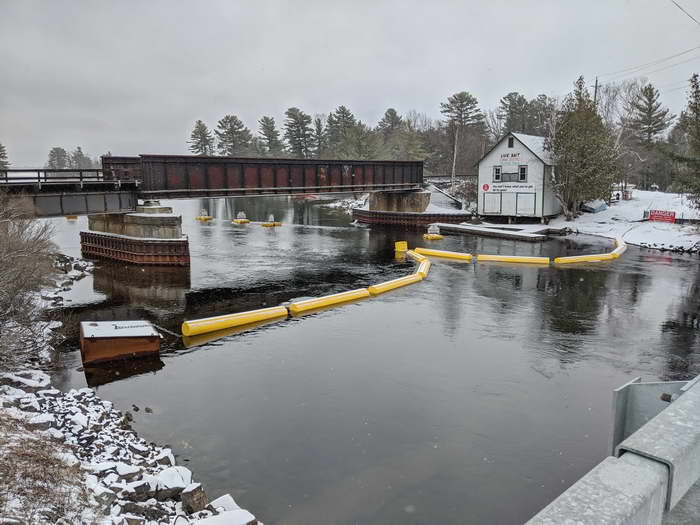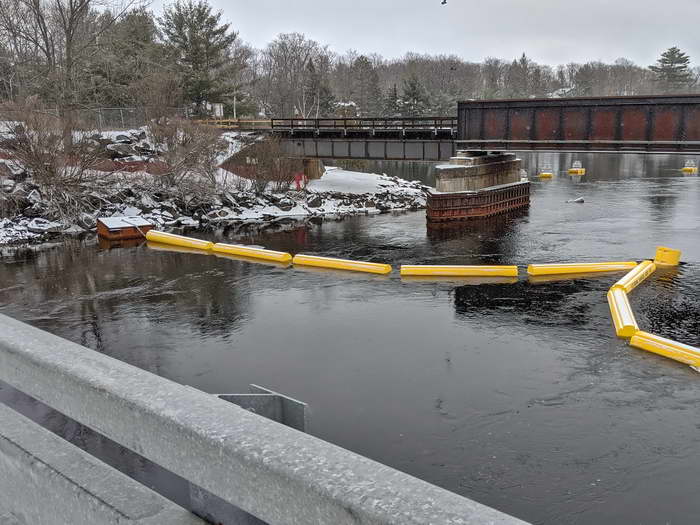Swift River Energy Limited’s operation of their Bala north dam hydro-electric generating station has inadequate public safety measures, and is not compliant with their:
- Own Public Safety Measures Plan, and therefore the requirements of the Ministry of Natural Resources and Forestry.
- Approval under the Navigation Protection Act from Transport Canada.
- Approval Environmental Screening/Review report Addendum, and therefore the requirements of the Ministry of the Environment, Conservation and Parks.
As detailed below; the education and information provided to the public is inadequate, the warning signs are non-compliant and confusing, the public safety measures are inadequate, and the design of the upstream safety boom is both non-compliant and extremely dangerous as it prevents rather than enables self-rescue.
1) Non-compliance with their Public Safety Measures Plan:
- Pages 12 and 13 state a horn would be sounded to warn people in hazardous zones. The generating station’s operation causes flows so great that it causes white-water outside of their downstream safety boom (example photograph taken July 15, 2021 here), and the flow is so great at Purk’s Place docks that canoes cannot be paddled away. People outside of the safety booms will clearly be in hazardous zones created by the operation of this generating station, yet there has never been a horn sounded.
- Page 17 states there would be a “Public Education Plan” which would “Inform the public about the risks and hazards related to the Bala G.S.”. But:
- When the generating station suddenly shut down recently due to a power failure in the area, the pressure wave which this created travelling upstream in the Bala north channel was so high that it unhooked the dock ramp at Purk’s Place. But there has never been any education provided to prepare for this danger long known to Swift River Energy Limited.
- There has never been any education of when the flow caused by the generating station is too great for people to paddle canoes from Purk’s Place. There has been no education on what to say to people about this flow to people that wish to rent canoes from Purk’s Place.
- There has never been any education that the white-water exiting the downstream safety boom would knock someone off a stand-up paddle-board.
- There has not been any education about whether people can continue to Scuba dive from Diver’s Point or below the Bala north falls, as people have safely done for decades.
- There has not been any education that there is a rail below the upstream safety boom which could help support people while they hope someone will rescue them.
- This is all like buying a car and the manufacturer saying “you figure out if the brakes work”. It should not be for the public, one at a time, to figure out the dangers created by trial and error, or death. It is unprecedented to build such a dangerous facilityin the middle of a popular in-water recreational area, yet Swift River Energy Limited has not provided the education and public safety measures required.
- Appendix A, Sections and Details, states that:
- The upstream safety boom is to be anchored on the north shore. This has not been done.
- The floating signs are to be anchored “to ensure that the orientation of the signs can be maintained”. Many of these signs are rotated and their warnings are therefore incorrect and confusing.
- Appendix A, Plan View:
- Shows that the north end of the upstream safety boom is anchored on the shore. This has not been done.
- States that: “Safety boom modified to improve self-rescue”. This has not been done, instead, as detailed below, the design prevents self-rescue.
Self-rescue is an extremely important public safety concept, in this case the upstream safety boom should be sloped so that as a person moving along it towards shore would be going downstream, so that the assistance of others is not needed.
But a person hanging-on to the north half of the safety boom would not be able to reach shore as:
- They would first encounter the huge concrete-filled rusty steel box which anchors the north side of the upstream safety boom (see photograph below). This has nothing to hang-on to, and it would block people from getting to the north shore, has a gap so people could get pulled downstream south of it, so people would be trapped in an extremely dangerous location rather than facilitating self-rescue. And the upstream floating signs and their anchor chains prevent a boat from getting to the upstream safety boom to rescue someone trapped there.
- The water level is usually higher so this steel box is submerged. So anyone standing on it trying to get to shore, and anyone going to shore from it would have to go around the north end of the safety boom, exposing them to the extreme danger of being swept downstream to their death.

And even if a person could reach the north shore, as you can see below it is steep, covered with sharp rocks (swimmers would not be wearing shoes), and has branches, so many could not get out of the water there (and there’s a fence at the top).

The previous version (which is dated March 2011) of the Public Safety Measures Plan is included in this file (here), and this includes the “Point of No Return” calculation which is used by Transport Canada and by the Ministry of Natural Resources and Forestry. This calculation shows how far upstream of a hazard a safety boom needs to be placed. The calculation valid before the generating station was built (when the downstream hazard was only the Bala north dam) is the last page of this document. This calculation is updated to account for the construction of the generating station here, and this shows that for public safety the upstream safety boom is to be farther upstream. This has not been done.
As Swift River Energy Limited’s Bala north dam hydro-electric generating station does not comply with its Public Safety Measures Plan, it should not be operated during the in-water recreational season.
2) Non-compliance with approval by Transport Canada under the Navigation Protection Act:
As you can see in Transport Canada’s approval:
- The first page states that the work must be: “built according to the plans”.
- These plans follow that first page: Drawings “General Plan View” (page 3) and “Portage Trails, Safety Boom and Habitat, Typical Details” (page 5, “Typical Safety Boom Profile”) both show that both ends of the upstream safety boom are anchored to the shore. This has not been done. Indeed the north end of the upstream safety boom is shown to be anchored at the top of the north shore slope to help someone get to safety, but this too has not been done.
As this work has not been done according to the plans, Swift River Energy Limited’s Bala north dam hydro-electric generating station is not compliant with their approval from Transport Canada.
3) Non-compliance with approval for their Environmental Screening/Review report Addendum, from the Ministry of the Environment, Conservation and Parks:
The public rightfully expects that flows outside of Swift River Energy Limited’s safety booms would be safe for in-water recreation. Indeed this was a commitment made by Swift River Energy Limited in Section 6.2.4 and shown in Figure 6.4 of the Environmental Screening/Review report Addendum, as this approval requires that Swift River Energy Limited: “must implement the Project in the manner it was developed and designed, as set out in the Environmental Screening Report”. Proof this generating station is creating extreme dangers outside of the safety booms includes:
- The three “near miss” incidents, here, here, and here.
- That flow downstream is so great that it creates white-water as it passes by the floats of the downstream safety boom.
- That the sign posted at the portage at the Moon River states: “Danger, no swimming, strong undertow and currents”. This is insane, people often tip out of a canoe when getting in or out of it – and then they’re swimming. It makes no sense to build a portage directly beside the extremely-dangerous tailrace flow of the generating station and then tell people they can’t swim there. The flow down the Bala north falls and Bala south channel is natural so can be seen and judged, but the tailrace flow from the generating station is unnatural, from 25′ below the surface and far below the natural bottom of the Moon River. How is the public to know how far this claimed “No swimming” area extends. Swift River Energy Limited has no right to make this public resource dangerous outside of the safety booms.
This all reeks of inexperience, the standard warning signs on the generating station even have a spelling mistake.
4) The community has long warned about Swift River Energy’s inadequate public safety measures. As summarized in this September 28, 2015 article about the September 1, 2015 Acquatic Safety Audit report:
- “The proposed installation of a hydroelectric generating station adjacent the Bala North Falls dam would create extreme new dangers, to both upstream and downstream in-water recreation.”
- “In whole, this development would create an unusually and extremely dangerous situation, and therefore requires a commensurate level of planning to be presented to agencies, stakeholders, and the public. This process should be started and completed before any construction proceeds, to both ensure it would be practical to implement, and so that any required changes could be incorporated into the design of the proposed station.”
In summary, due to their inadequate public safety measures, it is irresponsible for Swift River Energy Limited to continue to operate their hydro-electric generating station.